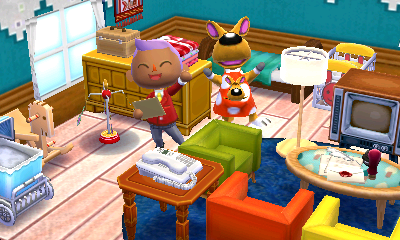Nintendo finally hones in on an objective for its latest Animal Crossing game (not that Wii U one it just announced).
Animal Crossing: Happy Home Designer takes Nintendo’s animal village sandbox and strips away some of the elements that make up its open-ended community gameplay (think mail checking, tree shaking), zeroing on one specific aspect: home design. Happy Home Designer goes beyond a your in-game abode, putting you to work as an architect and planner for an entire town. Nintendo’s new twist on the 14-year-old franchise releases on Nintendo 3DS later this year, and GamesBeat got an early look.
[aditude-amp id="flyingcarpet" targeting='{"env":"staging","page_type":"article","post_id":1743145,"post_type":"preview","post_chan":"none","tags":null,"ai":false,"category":"none","all_categories":"games,","session":"D"}']Players take on the role of an upcoming home designer at Nook’s Homes in New Town (yes, Tom Nook is your boss). Villagers from games past as well as new residents (333 in all) all await your services for their homes, which will have players not only influencing clients’ homes, but eventually the entire town. It’s not as much work as it sounds.
Even with this specific focus, Happy Home Designer is still quite open-ended. When you meet a new client, they will tell you their wishes, but you are free to interpret them however they wish. You create both the interior and exterior of clients’ homes, choosing from a wealth of design options, trims, decorations, and accessories, with even more options unlocking as the player progresses. Just like the previous Animal Crossing games, finding cool new accessories and decorations drives players to explore and interact more.
Skunk and deer
My first client was a skunk (I think) named Stinky. He likes wrestling and wanted an in-home grapplin’ experience. Outside, I worked from a blank slate, picking the home’s design from several options, and then customizing it with my pick of a roof, doors, and finish options. Custom fencing, plant life, and yard decorations all came easily through touchscreen operation — simply drag and drop where you’d like things.
Inside, four boxes sat in empty room. These were four pieces of a wrestling ring, and tapping the screen let me open them and reorient them to design around. While players are free to place any objects in the library in their designs, recommendations in the design catalog fit with the given theme. In this case, a boom box, a fight bell, and other related items were suggested. I placed them, and then flipped through the catalog looking for more interesting items.
The catalog features tabs that separate decorations by type, putting things like appliances or lighting in categories that can be sorted through easier. It even has one for music, and fans of the previous games will enjoy the selections available. You will eventually unlock all of the available items by taking on missions and meeting new characters.
My next design was for an adorable deer named Fauna, who wanted me to bring the music home with some sort of musical design. I gave her a lopsided home with a monochromatic paint job, but I went nuts inside, adding a full string section, accosting walls and floors, music stands, and mood lighting to her existing grand piano. I could have just as easily went with a harpsichord or xylophone. For a touch of randomness, I added a vacuum cleaner. But I think I did well — as I placed the items around her home, she danced and reacted with cute expressions.
Amiibo Cards debut
Nintendo will use new NFC-enabled Amiibo cards to enrich Happy Home Designer. These cards represent characters, and you can scan them into the New 3DS XL’s built-in Amiibo sensor or through an optional card reader that makes older 3DS hardware compatible with the figures. The company has yet to state how these cards will be priced or sold.
This new Animal Crossing features an Amiibo Phone, which permits the scanning of a card to invite its character to the town. From there, the player can go to work on that character’s house, and then save the design to that card to be recalled later. The function also permits scanning other characters in to visit a finished home, where they will play, dance, and do other weird things, in classic Animal Crossing style.
[aditude-amp id="medium1" targeting='{"env":"staging","page_type":"article","post_id":1743145,"post_type":"preview","post_chan":"none","tags":null,"ai":false,"category":"none","all_categories":"games,","session":"D"}']
Without using these cards, players will have to wait for their favorite characters to appear randomly in the lineup of over 300 others. And Nintendo says that a few special character cards permit home design for characters that would otherwise only hang out and chat. It sounds like collecting these Amiibo cards is a must to see every aspect of Happy Home Designer.
You just have to try it
Even with the design-focused play, as with other Animal Crossing games, it’s hard to adequately describe the gameplay. I fear that it sounds too simple on paper, and I know that none of the charm or classic Animal Crossing humor comes through here.
I found it very easy to get lost in my design choices — I could have spent all day tweaking my work. Even with the limited catalog and half an hour, I already felt my inner home designer coming out. And who knows what surprises await elsewhere in town. It’s just one of those games that you have to experience for yourself.
